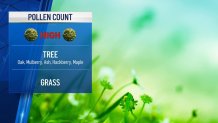Pollen is a major source of outdoor allergies and levels can be impacted by wind, humidity and thunderstorms.
As we head through the spring and summer months tree and grass pollen levels are the main culprits to your suffering. Your allergies may also be caused by mold which flourishes in the heat and humidity and can stay airborne through the summer.

A grain of pollen is made up of a few layers. The outer layer protects the pollen from deteriorating. The inner layers are the pollen allergen proteins, the “stuff” that makes your eyes itch and nose run.
Get top local stories in DFW delivered to you every morning. Sign up for NBC DFW's News Headlines newsletter.
Pollen is released from a plant when the plant notices a decrease in humidity.
Time of Day
Pollen levels are lower in the morning with dew and humidity and increase through the afternoon. Humidity levels are highest in the morning and generally drop throughout the day.
Weather Connection
Connecting you with your forecast and all the things that make North Texas weather unique.
Rain
Rain is a big factor in pollen levels. Weather systems with a steady rainfall of smaller droplets will wash the pollen out of the air. Larger water droplets are less effective at removing pollen from the air.
Thunderstorms
Pollen grains burst when they are exposed to water and this releases more of the inner core of the allergen. This can occur in thunderstorms when pollens are taken into an updraft of a thunderstorm into the clouds and burst with the moisture from the clouds.
Later, the downdraft winds of the thunderstorm will bring the pollens back the ground. This is the main reason allergies can flare up after a thunderstorm.



